Clayton Kershaw, like many big-name free agents, is waiting until the conclusion of the lockout to find a potential new home. The three-time Cy Young award winner is finally hitting the open market for the first time in his career. The Dodgers locked him up a year before free agency in 2014 when they inked him to a massive seven-year, $215M deal. Kershaw opted out of that deal after the 2018 season, only to re-sign with the Dodgers for three more years.
While Kershaw has generally been as consistent as one can be over the course of his career, 2021 opened a lot of questions about the volatility of both his health and stuff. Nothing until this year has been super limiting; Kershaw’s inning low (outside of 2020 and rookie year) of 149 IP in 2016 shows his dependability at the top of the Dodgers rotation. Kershaw’s 121.2 IP in 2021 is the second-lowest of his career, which is not ideal for an aging veteran. He spent about three months of 2021 on the injured list dealing with an elbow injury that ultimately resulted in a missed postseason. Luckily, the injury did not require surgery and instead just a PRP injection, leading Kershaw to believe that he would be ready for Spring Training 2022.
Although I just talked about all the scary parts about Kershaw, 2021 was still a solid season. He posted a 3.55 ERA and a 1.02 WHIP across 121.1 IP, but the peripherals suggest his 2021 was better than a 3.5 ERA. A FIP of 3.00 and an xFIP of 2.87 shows that his actual results were a little bit worse than they should’ve been. This was likely due to his .289 BABIP, a significantly higher value than recent seasons, and his career .270 mark.
Now, the Texas native is a free agent as he enters his age-34 season. Fangraphs estimates that he will get somewhere in the ballpark of $23M AAV for either two or three years; most believe he’ll return to Los Angeles on a short deal or have a homecoming with the Texas Rangers. Where he ends up, who knows, but who will Kershaw be as a pitcher in the next, and potentially final, chapter of his Hall of Fame career?
https://gfycat.com/acceptablelivelyblackandtancoonhound
First, Kershaw’s fastball velocity is the biggest “if” for how much he will be making in his next contract. Even though he is an established veteran, it almost feels like he may need to throw offseason bullpens in front of scouts to show where he is at post elbow injury. Since sitting between 93-94 MPH from his rookie year to 2016, he has been on a slow decline in velocity through 2021. His 2020 fastball was actually a slightly raised velocity, but that might’ve been due to the smaller workload required for the 60 game season. In 2021, his fastball averaged 90.7, which is getting dangerously close to a sub-90 mark.
From 2017 to 2020, the lack of velocity has been of little worry for Kershaw, who has shown his ability to adjust his fastball approach and still find success. Since Statcast started tracking spin rate in 2015, Kershaw has increased the spin rate of his fastball each season. He was aware that his velocity was teetering on the brink of falling off and found ways to stay efficient.
| Year | Fastball Velocity (in MPH) | Fastball Spin Rate Percentile |
|---|---|---|
| 2015 | 94.2 | 54 |
| 2016 | 93.6 | 65 |
| 2017 | 92.9 | 75 |
| 2018 | 90.8 | 85 |
| 2019 | 90.3 | 91 |
| 2020 | 91.6 | 91 |
| 2021 | 90.6 | 95 |
As the table shows, Kershaw rapidly took his fastball’s spin from league average to elite, which helped keep the fastball as a plus pitch even when the velocity went down. And before anyone says anything, sticky stuff had no effect on the fastball spin rate. Below is the fastball spin rate over the course of the 2021 season.
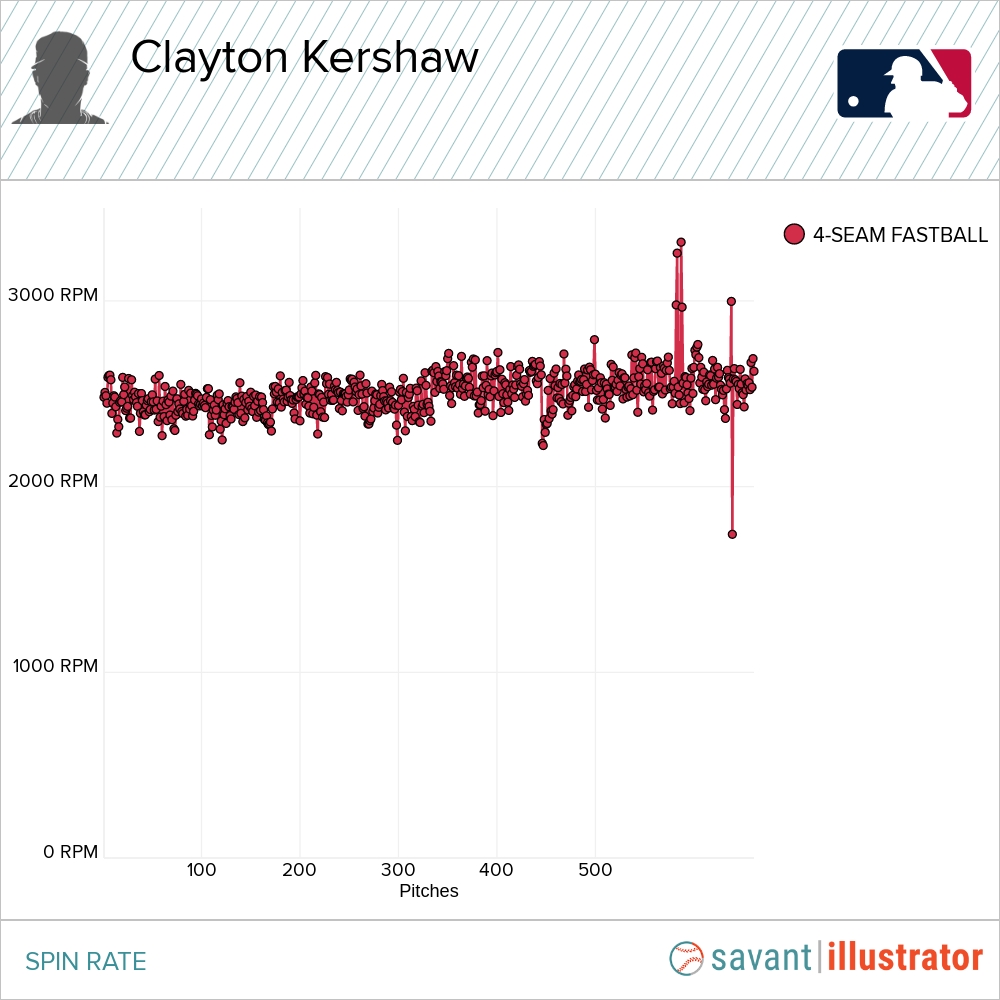
If anything, there is a slight increase in RPM later in the summer and no massive drop suggesting a change in the use of sticky stuff.
Unfortunately, fastball spin can only be so beneficial when the velocity is fading and any further drop might create fatal problems for Kershaw’s career. After hovering at 90/91 MPH for a few seasons, hitters are starting to figure out the spin-efficient fastball. By run value, Kershaw’s 2021 fastball was his worst since at least 2017 (when Statcast started documenting it) and likely the worst of his career too.
| Year | Run Value |
|---|---|
| 2017 | -13 |
| 2018 | 0 |
| 2019 | -18 |
| 2020 | -5 |
| 2021 | 5 |
Kershaw’s fastball in 2018 appears as an anomaly compared to the surrounding years, but it is clear that the fastball is losing the power it once had. In 2021, the fastball had a .299 BA and .361 wOBA against, both figures well below league average for fastballs. As Kershaw has essentially plateaued on finding spin on the pitch, a continued loss of velocity will cause hitters to tee off on a sub-90 MPH pitch. Throughout the entire league, the average wOBA on fastballs was .353. On sub-90 MPH fastballs (minimum 100 thrown), the average wOBA against was .370. Granted, Kershaw has been good enough throughout his entire career that he could find a way to survive, similar to Zack Greinke, but the struggles the fastball showed in 2021 are not exactly encouraging.
How has Kershaw dealt with the fading fastball? He’s tanked its usage and instead relied on his legendary slider.
Kershaw’s slider has always been his money pitch. Even though the curveball is cathartic to watch as it buckles knees, the slider is Kershaw’s real bread and butter. With the pitch being as good as it is, Kershaw has relied on it harder than ever and more than anyone else in baseball. As Zach Hayes wrote here in May, no starting pitcher was throwing a slider more than Kershaw. By the end of the season, Kershaw still threw the slider more than anyone (min. 10 starts). It became his primary pitch, being thrown 48.3% of the time, and he reaped rewards from its effectiveness. The slider had an absurd 27.3% SwStr% and a 44% Whiff%, ranking 2nd and 7th respectively of all sliders (min. 300 thrown).
Kershaw’s slider was filthy all season long, primarily throwing it as a backfoot slider to righties. Seen below is a perfectly executed pitch to strike out Fernando Tatis Jr.
https://gfycat.com/colorlessperfumedgannet
The pitch looks very similar to the fastball and instead just bottoms out where a hitter is anticipating the ball. In terms of spin relative to the fastball, Kershaw’s slider is significantly different than other great fastball/slider combos.
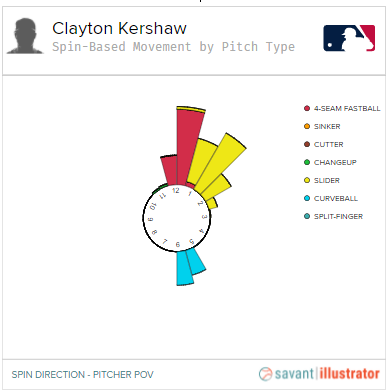
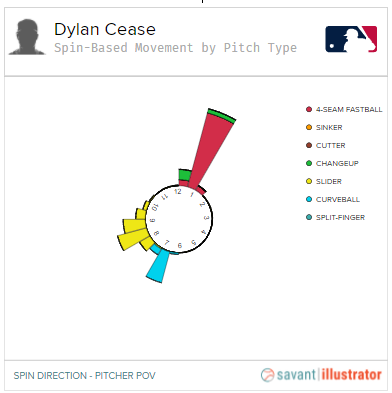
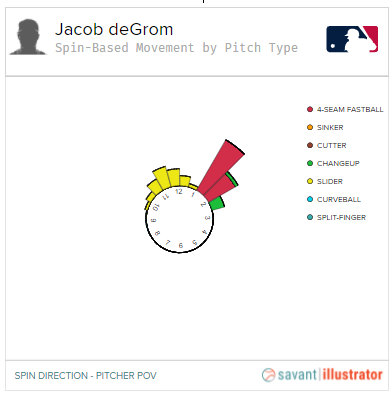
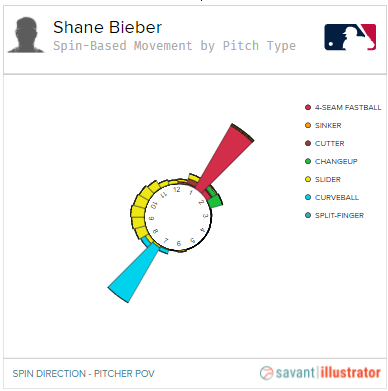
The first thing to notice on all four of these Baseball Savant illustrations is that Kershaw is the only LHP of the group, so his slider moves inversely to the three RHP sliders. The second thing to notice is how there is an overlap between Kershaw’s slider movement and fastball movement, which is unlike any other pitcher shown. The ability to closely resemble the fastball is where Kershaw has success with the pitch, as hitters struggle to identify the spin of the slider compared to the fastball. Hayes’ article also touches upon the unique spin and movement profile of the pitch (and goes a little more in-depth about it).
This is actually a great sign for Kershaw’s future, as he is clearly exhibiting how he can succeed with a low-velocity fastball. As long as the slider velocity does not drop off and creates a large gap between the two pitches, Kershaw should be able to employ this approach for the coming years. There’s been an average difference of about 3.5 MPH between the fastball and slider over the last three seasons, which has tightened as the fastball velocity has decreased.
Additionally, Kershaw’s elite command is on display with his use of the slider, where he lives down-and-in to righties and works with confidence. When looking at the slider heatmaps, Kershaw is not afraid to throw a swing and miss pitch even behind in the count. Below, the first heatmap is the overall slider location, the second heatmap is behind in the count, and the third heatmap is ahead in the count.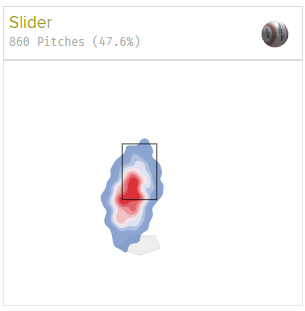
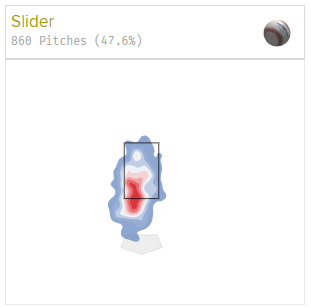
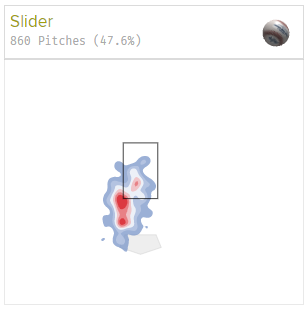
As the heatmaps show, Kershaw pounded one quadrant of the strike zone and did not hesitate when he fell back in the count. While it might seem like common sense that he throws his most frequent pitch with confidence, Kershaw isn’t getting scared when he falls behind in counts and isn’t turning to the fastball. Kershaw is putting all his trust in the slider, and it is working beautifully. In the second heatmap, the hotspot does creep up closer to the middle-middle of the zone, but there is also a strong hotspot just below the strike zone as well. Knowing the similarities to his fastball, Kershaw gets whiffs out of the zone while behind in the count as hitters may be sitting fastball and get something else. Then, when he’s ahead in the count, Kershaw tries to either dot the corner or make it completely unhittable.
When reviewing the pitch usage by count, one can see how confident Kershaw is with the pitch regardless of the situation.
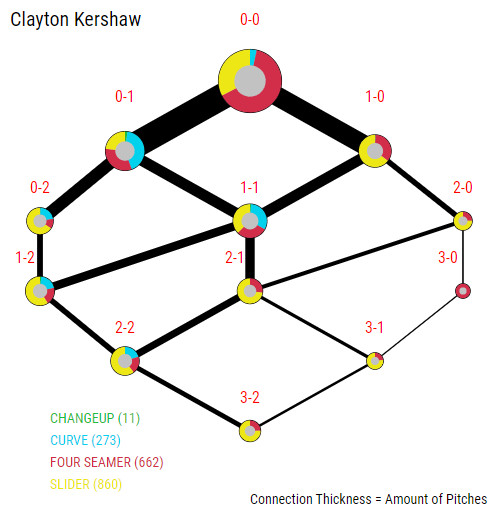
Kershaw is able to throw the slider as a primary pitch in whatever count he is in, regardless of if he’s behind 2-0 or ahead 1-2. If he throws a first-pitch strike, which he does 62.9% of the time, it’s easier for him to work in his fastball or curveball earlier, but he does not need to worry because the slider truly works in all counts. The elite command of the slider is a big part of maintaining his extremely low 4.3% walk rate, good for the 3rd lowest among pitchers (min. 100 IP).
While the slider is what is keeping Kershaw afloat, it’s hard to forget the curveball which has been essential as an out pitch throughout his career. Thrown primarily when ahead or even in counts, Kershaw’s curveball can freeze hitters and upend an entire at-bat. However, similar to the fastball, its effectiveness has faded over the last few seasons. That’s not saying that the pitch is bad per se, but the stats behind the pitch don’t exactly show good things. Over the last five seasons, Kershaw has seen pretty harsh decreases in chase rate and CSW% but the whiff rate and wOBA against have still held strong.
As the chart shows, the curveball’s ability to generate whiffs outside the strike zone (o-swing% being chase rate) has dropped precipitously, especially in 2021. The pitch is becoming less effective at getting ugly swings out of the zone and instead Kershaw is getting more swings and misses from within the zone. The curveball is maintaining its whiff ability and wOBA against, suggesting that the pitch is still legitimate. That may be partially luck or a “Kershaw” factor: that he’s so good at what he does that he just makes the curveball work. Kershaw has transitioned to a more chaotic location of the pitch and it’s unclear if that’s intentional or not.
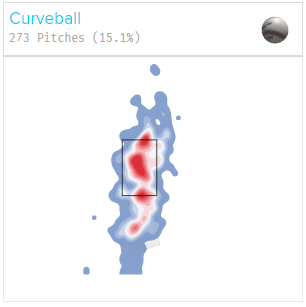
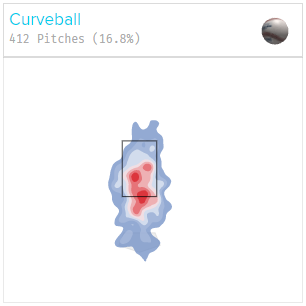
On the left is Kershaw’s heatmap from 2021 and on the right is Kershaw’s heatmap from 2017. It is clear that Kershaw wants to keep the pitch in the center of the plate and vary the height of the pitch, but how much variance in height is the big change. In 2017, Kershaw was very concise with where he wanted to put the pitch and it yielded a .194 wOBA and a -5 run value. In 2021, Kershaw basically threw it wherever as long as it was in the center of the plate. The 2021 curveball returned a .198 wOBA and a 0 run value, suggesting that the wOBA this season was slightly luckier and the lack of chases had an effect on performance. Below is a good example of the knee-buckling curveball, where Kershaw gets Kyle Tucker looking on a pitch right in the zone.
https://gfycat.com/defenselesscloudyeuropeanfiresalamander
Despite the stagnating wOBA and other batted ball stats, it seems like the curveball is currently walking the plank before it falls apart. The underlying stats suggest that the curveball is reaching the end of its days unless Kershaw finds a way to work his magic and revive the pitch. Furthermore, the decreasing fastball velocity will make it easier to recognize the curveball, which unfortunately damages two out of Kershaw’s three pitches.
Finally, Kershaw’s future performance will be partially dependent on where he ends up. By returning to Los Angeles, Kershaw will once again be surrounded by coaches and players he’s known for years and there will not be a phase of adapting to new support staff. If he goes elsewhere, coaches may want to try something else with his stuff and mess with Kershaw’s own way of dealing with age. Dealing with a new coaching staff may not be a huge deal for a guy like Kershaw, but weird things have happened when players switch teams. Regardless, the slider is elite and will be able to drag the fastball and curveball along with it.
Overall, if Kershaw can enter 2022 fully healthy, he is likely capable of putting up above-average production for at least a couple of seasons. It may not be the Kershaw we all know and love, but it won’t be a struggling 4.40+ ERA for the future Hall of Famer. He is only 34 and while the health hasn’t been great, he has thrown over 100 IP every year of his career (excluding 2020). 2021 was one of his smallest years yet in terms of volume, but he said he will be healthy for Spring Training (whenever that is) so major health issues should not start tearing him apart yet. Steamer projections have Kershaw at a 3.57 ERA for 2022 and the range of 3.5-4 ERA might be his new home as he rides off into the sunset.
Photos from Icon Sportswire | Adapted by Justin Redler (@reldernitsuj on Twitter)
